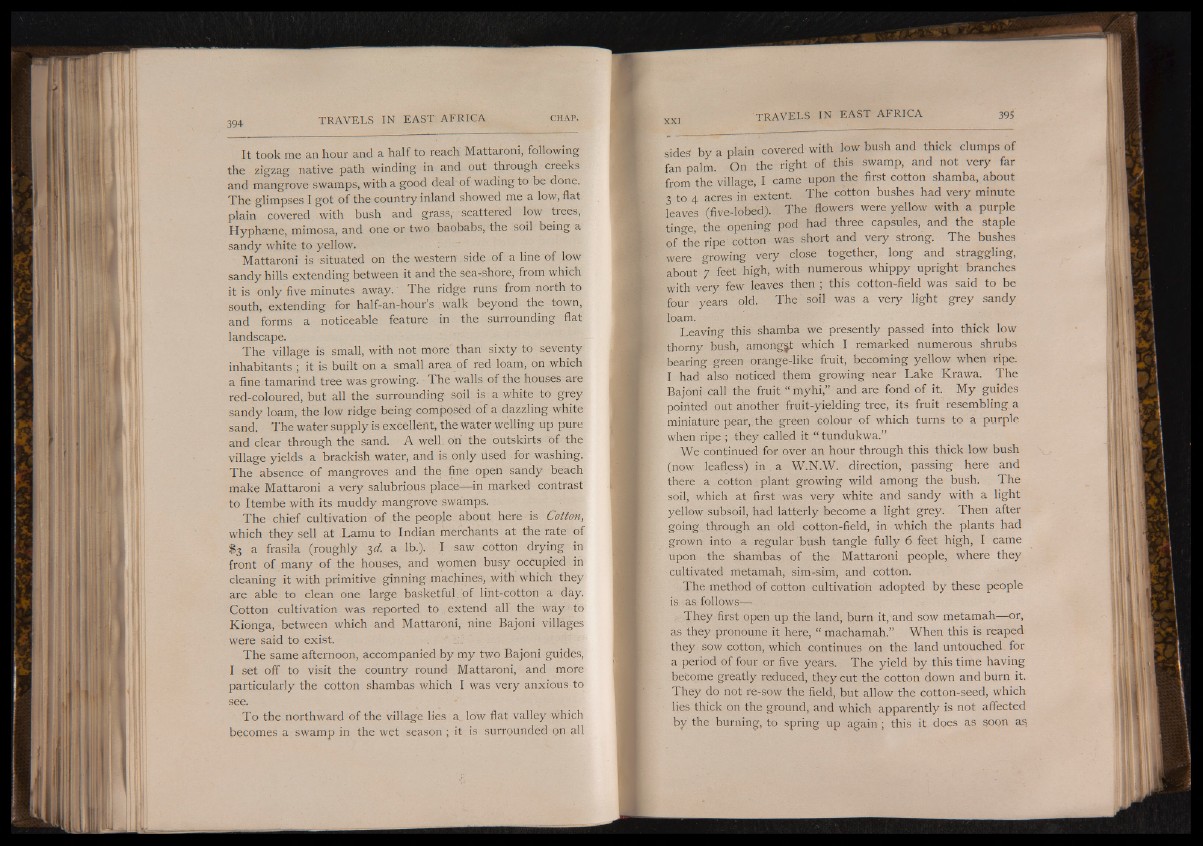
It took me an hour and a half to reach Mattaroni, following
the zigzag native path winding in and out through creeks
and mangrove swamps, with a good deal of wading to be done.
The glimpses I got of the country inland showed me a low, flat
plain covered with bush and grass,- scattered low trees,
Hyphsene, mimosa, and one ,or two baobabs, the soil being a
sandy white to yellow.
Mattaroni is situated on the western , side of a line of low
sandy hills extending between it and thè sea-shore, from which
it is only five minutes away. The ridge runs from north to
south, extending for half-an-hour’s walk beyond the town,
and forms a noticeable feature in the surrounding flat
landscape.
The village is small, with not more than sixty to seventy
inhabitants ; it is built on a small area of red loam, on which
a fine tamarind tree was growing. The walls of the houses are
red-coloured, but all the surrounding soil is a white to grey
sandy loam, the low ridge being composèd of a dazzling white
sand. The water supply is excellent, the water welling up pure
and clear through the sand. A well: on the outskirts of the
village yields a brackish water, and is only used for washing.
The absence of mangroves and the fine open sandy beach
make Mattaroni a very salubrious place— in marked contrast
to Itembe with its muddy mangrove swamps.
The chief cultivation of the people about here is Cotton,
which they sell at Lamu to Indian merchants at the rate of
$3 a frasila (roughly 3d. a lb.). I saw cotton drying in
front of many of the houses, and women busy occupied in
cleaning it with primitive ginning machines, with which they
are able to clean one large basketful. of lint-cotton a day.
Cotton cultivation was reported to extend all the way to
Kionga, between which and Mattaroni, nine Bajoni villages
were said to exist. . Ì0
The same afternoon, accompanied by my two Bajoni guides,
I set off to visit the country round Mattaroni, and more
particularly the cotton shambas which I was very anxious to
see.T
o the northward of the village lies a low flat valley which
becomes a swamp in the wet season ; it is surrounded on 3-U
sides by a plain covered with low bush and thick clumps of
fan palm. On the right of this swamp, and not very far
from the village, I came upon the first cotton shamba, about
3 to 4 acres in extent. The cotton bushes had very minute
leaves (five-lobed). The flowers were yellow with a purple
tinge the opening pod had three capsules, and the staple
of the ripe cotton was short and very strong. The bushes
were growing very close together, long and straggling,
about 7 feet high, with numerous whippy upright branches
with very few leaves then ; this cotton-field was said to be
four years old. The soil was a very light grey sandy
loam.
Leaving this shamba we presently passed into thick low
thorny bush, amongst which I remarked numerous shrubs
bearing green orange-like fruit, becoming yellow when ripe.
I had also noticed them growing near Lake Krawa. The
Bajoni call the fruit “ myhi,” and are fond of it. My guides
pointed out another fruit-yielding tree, its fruit resembling a
miniature pear, the green colour of which turns to a purple
when ripe ; they called it “ tundukwa.”
We continued for over an hour through this thick low bush
(now leafless) in a W.N.W. direction, passing here and
there a cotton plant growing wild among the bush. The
soil, which at first was very white and sandy with a light
yellow subsoil, had latterly become a light grey. Then after
going through an old cotton-field, in which the plants had
grown into a regular bush tangle fully 6 feet high, I came
upon the shambas of the Mattaroni people, where they
cultivated metamah, sim-sim, and cotton.
The method of cotton cultivation adopted by these people
is : as follows--
They first open up the land, burn it, and sow metamah— or,
as they pronoune it here, “ machamah.” When this is reaped
they sow cotton, which continues on the land untouched for
a period of four or five years. The yield by this time having
become greatly reduced, they cut the cotton down and burn it.
They do not re-sow the field, but allow the cotton-seed, which
lies thick on the ground, and which apparently is not affected
by the burning, to spring up again; this it does as soon as